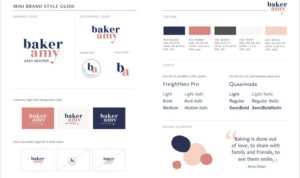Developing a Storytelling Brand Strategy sets the stage for this enthralling narrative, offering readers a glimpse into a story that is rich in detail with American high school hip style and brimming with originality from the outset.
Importance of Developing a Storytelling Brand Strategy
In today’s competitive business landscape, having a compelling storytelling brand strategy is essential for companies to stand out from the crowd and connect with their target audience on a deeper level. By leveraging the power of storytelling, businesses can create a unique identity, build trust, and foster emotional connections with customers.
Examples of Successful Brands
- Apple: Apple’s brand story revolves around innovation, design, and simplicity. Their iconic “Think Different” campaign is a prime example of how storytelling can resonate with consumers and create a loyal following.
- Nike: Nike’s brand story is rooted in the idea of empowerment and inspiration. Through their “Just Do It” campaign, they have successfully connected with athletes and fitness enthusiasts worldwide, encouraging them to push their limits.
- Coca-Cola: Coca-Cola’s branding is all about happiness, togetherness, and nostalgia. Their timeless campaigns, such as the “Share a Coke” initiative, have evoked emotions and created lasting memories for consumers.
Creating Emotional Connections
A well-crafted brand story has the power to evoke emotions, resonate with values, and create lasting impressions on customers. When consumers feel emotionally connected to a brand, they are more likely to develop brand loyalty, advocate for the brand, and engage with its products or services on a deeper level.
Elements of a Compelling Brand Story: Developing A Storytelling Brand Strategy

Crafting a compelling brand story involves incorporating key elements that resonate with the audience, creating an emotional connection that goes beyond just products or services.
Authenticity in Brand Storytelling
Authenticity plays a crucial role in shaping a brand’s storytelling strategy. Customers are more likely to engage with a brand that is genuine and transparent in its messaging. By staying true to its values and identity, a brand can build trust and loyalty among its audience.
- Consistency: Consistent storytelling across all platforms helps reinforce the brand’s authenticity and credibility.
- Transparency: Being open and honest about the brand’s values, practices, and products builds trust with consumers.
- Humanization: Adding a human touch to the brand story by sharing personal experiences or customer stories can make the brand more relatable.
Defining Brand Values and Mission
Defining a brand’s values and mission is essential in storytelling as it provides a clear direction and purpose for the brand narrative. By articulating what the brand stands for and aims to achieve, storytelling becomes more focused and impactful.
“Your brand values are the guiding principles that shape your brand story and how you communicate with your audience.”
- Identity: Brand values help define the brand’s identity, distinguishing it from competitors and creating a unique positioning in the market.
- Alignment: Ensuring that the brand’s values and mission align with the storytelling strategy helps maintain coherence and authenticity in communication.
- Inspiration: Communicating a brand’s mission can inspire both internal employees and external customers, fostering a sense of purpose and connection.
Crafting a Unique Brand Narrative

Creating a brand narrative that stands out from the competition is crucial for grabbing the attention of consumers in today’s crowded marketplace. Here are some tips on how to develop a unique brand narrative that sets your business apart:
Show Your Authenticity, Developing a Storytelling Brand Strategy
- Be true to your brand’s values and mission.
- Share the story behind your brand’s founding and what drives you.
- Highlight what makes your brand unique and different from others.
Create Emotional Connections
- Evoke emotions through your storytelling to resonate with your audience.
- Use personal anecdotes or customer testimonials to make your brand relatable.
- Showcase how your brand can make a positive impact on people’s lives.
Be Consistent Across Channels
- Maintain a consistent brand voice and messaging across all marketing platforms.
- Ensure that your brand story is integrated into your website, social media, advertising, and other communication channels.
- Reinforce key brand elements in all your storytelling efforts to build brand recognition.
Examples of Brands with Unique Narratives
- Apple: Known for its minimalist design and innovative technology, Apple’s brand narrative focuses on creativity and challenging the status quo.
- Nike: Nike’s brand story revolves around empowerment and pushing the boundaries of what is possible, inspiring athletes to strive for greatness.
- Patagonia: Patagonia’s narrative centers on sustainability and environmental activism, resonating with consumers who value ethical practices.
Implementing Storytelling in Marketing Campaigns
Storytelling can be a powerful tool when integrated into various marketing campaigns. It helps brands connect with their audience on a deeper level, creating emotional engagement and brand loyalty.
Incorporating Storytelling into Social Media Marketing Efforts
- Utilize user-generated content to tell real stories about your brand.
- Create a consistent brand voice and narrative across all social media platforms.
- Use visual storytelling through images and videos to capture attention and convey your brand message.
- Engage with your audience through interactive storytelling techniques like polls, quizzes, and behind-the-scenes content.
Storytelling in Influencer Collaborations and Brand Partnerships
- Partner with influencers who align with your brand story and can authentically tell it to their followers.
- Create co-branded storytelling content that showcases the partnership in a compelling way.
- Encourage influencers to share personal anecdotes or experiences related to your brand to connect with their audience emotionally.
- Leverage influencer collaborations to reach new audiences and amplify your brand story through different perspectives.



